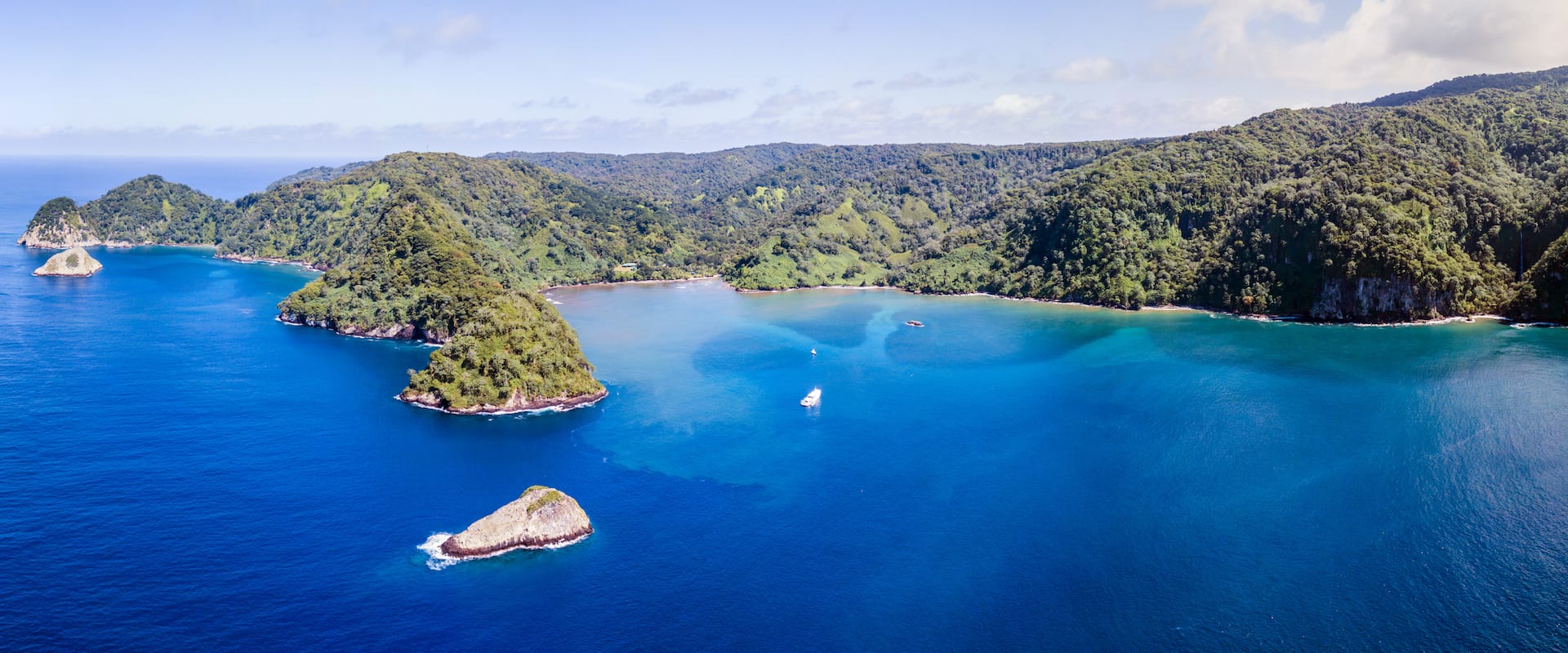Liveaboard Diving in Costa Rica
With marine sanctuaries and remote islands harboring giant rays, sharks and whales, scuba diving in Costa Rica is the ultimate liveaboard adventure.
Liveaboard diving in Costa Rica is the big draw for divers who wish to explore the amazing dive area Cocos Island - where it's become known as a hotspot for large schools of sharks. Lying between the marine rich waters of the Pacific Ocean and the Caribbean Sea, Costa Rica is a small but bold Central American country, blessed with stunning rainforests, diverse wildlife, and incredible scuba diving. Liveaboard diving in Costa Rica will allow the adventurous to travel far out to sea, exposing themselves to an underwater world rarely matched across the globe.
Unlike several of its neighbouring countries whose diving is concentrated around the Caribbean, Costa Rica's best sites are mostly found in the Pacific. There really are endless opportunities for every level of diver, but by far and away the best sites are accessible only via liveaboard dive tour which often lasts more than 10 days and allows multiple dives per day. Several different sites will make for an unforgettable dive trip - shark diving at the Cocos Island is a diver's favourite, particularly with the high the numbers of Hammerheads at Bajo Alcyone.
Combine Cocos Island with Cano Island, Guanacaste, Bat Island, and Costa Rica is well up in the scuba diving hierarchy. LiveAboard.com features many different diving boats, each ensuring comfort, safety, and fabulous underwater experiences. Vessels come in many shapes and sizes, from large cruising yachts to converted submarine support boats, all offering itineraries to suit everyone. Tours range from 11 to 18 days, obviously meaning that you can log a large number of dives but also allow the odd day of relaxation on deck if you want without losing out on a significant proportion of available dive time.
Diving cruises normally depart early in the morning, with some operators offering a pick-up service from your choice of accommodation. A few liveaboard itineraries will include a hotel stay for the night before the tour sets sail. Getting to the remote dive sites of Costa Rica can take nearly 2 days, but your reward for this voyage involves jumping into some of the planet's most isolated and unspoiled marine reserves. Generally, the crew will arrange a 'check' dive so the guides can assess the general level and tailor the dive safari to meet the guests' needs best. This test dive will be on a beautiful reef, offering gentle, easy conditions to get into the swing of things before a busy few days!
The biodiversity afforded by the Pacific waters of Costa Rica is incredible, with pristine reef systems that support a wide range of marine life. There are abundant sharks here, with other large animals such as Manta Rays, Dolphins, and Whales.
The array of colors on show from the huge variety of reef fish and corals are dazzling, creating a stunning underwater landscape.
Dive Sites and Areas of Costa Rica
The Pacific coast, in particular, boasts several great dive sites, home to the full range of tropical coral and fish species. Liveaboard cruises allow exploration of a vast majority of these during a single trip.
Cocos Island is perhaps Costa Rica's best dive area. It's located over 500 kilometers from the mainland, so the only way to get here is by liveaboard. The Island has been a marine reserve for more than 30 years, so when combined with its remoteness, the diving here is pristine. Its most famous residents are Hammerhead Sharks which are regularly seen in abundance, along with many other shark species and large pelagics.
With some of the clearest waters in Central America, Cano Island, off the south Pacific coast of Costa Rica, is a tropical playground for all manner of species, in particular various reef sharks which frequent the area constantly.
The Bat Islands are accessed by a visit to Guanacaste Bay in the northwest of the country and have some of the best conditions for diving in Costa Rica. Diving is all year round, and due to the isolated position is rarely visited, allowing divers to enjoy Mantas, Turtles, Sharks, Dolphins, and Whales in relative peace.
Probably THE place to dive, and on all liveaboard itineraries in Costa Rica, is the site of Bajo Alcyone - within Cocos Island. It's here that the famous elegant scalloped Hammerhead Sharks can be seen - it's unlikely that you'll visit anywhere else in the world with a better chance of viewing these odd yet beautiful creatures.
When To Go
Due to its position near the equator, diving at Costa Rica's best sites is possible year-round. There are slight seasonal differences - the dry season is from December to May, thus offering calmer seas and the best visibility. In the rainy season, from June to December, the visibility is normally slightly less (although still commonly up to 25 meters!), but the increase in plankton can result in higher numbers of sharks, whales, and other marine life. Water temperature, on average, is a pleasant 28 degrees Celsius.
Tips for Travellers
Spanish is spoken nationally as the main language, but English is widely understood, especially in the tourism industry. ATMs are generally easy to find and will dispense the local currency - the Costa Rican Colón - and most major credit cards are widely accepted. Plug sockets are similar to the US (2-pronged), with a voltage of 110V and a frequency 60Hz.
Gear-wise, most liveaboard operators will have equipment available to rent on board, although you'll need to let them know when you book. Divers are welcome to bring their own equipment and are advised to have their certification and log books on hand.
How To Get There And Points Of Departure
Depending on the operator, liveaboard dive trips in Costa Rica tend to depart from a few different ports. Many will leave from Puntarenas, a 90-minute drive from the capital, San Jose. Check with your cruise operator; some will arrange a transfer from San Jose to Puntarenas, simplifying things. Others actually start the tour in San Jose, so transport to the relevant harbor is included. San Jose has a well-served international airport, with several large airlines flying directly here. Most flights transit through the US, so checking US transit visa requirements is a good idea. If you are embarking on a liveaboard tour in the Guanacaste region, you may be able to fly directly into the nearby Daniel Oduber International Airport from overseas.
A small number of dive cruises through Costa Rica actually start in Panama - at Puerto Pedegral near the city of David, which can be reached via bus (around 7 hours) or a domestic flight from Panama City. It's easy to fly into Panama City from many international locations.
Considerations
Liveaboard.com has various boats and operators, covering a wide range of budgets, from approximately $250USD to $500USD per person per night. Each liveaboard diving tour operator is different, but often extras you'll need to bear in mind are marine park fees, emergency evacuation plan, airport departure taxes, and fuel surcharges. Depending on your nationality, you may be able to visit Costa Rica without a visa. However, you should check this well in advance of traveling. It's normally necessary to have 6 months' validity on your passport, but this should be checked again.
Due to the remoteness of several dive sites in Costa Rica, many operators require divers to hold an Advanced Open Water qualification with a minimum of 30 - 50 logged dives.
As ever, it’s always recommended to purchase suitable travel insurance.
Costa Rica Diving Reviews
- 8.9 Fabulous
- 7.2 Good
- Jillian Z
United States
Very good. Lots of hammers, white tips.
Diving Costa Rica in June on the Okeanos Aggressor II
- 10.0 Exceptional
- Michael J
United States
Excellent chance to see hammerheads!
Diving Costa Rica in July on the Okeanos Aggressor II
- 9.6 Exceptional
- Peter Anthony Z
United States
An experience we will repeat again and will recommend to others
Diving Costa Rica in October on the Sea Hunter
- 9.6 Exceptional
- David D
United States
Diving Cocos on the Oceans Aggressor II has spoiled me. It's going to be hard to find a better live aboard trip.
Diving Costa Rica in April on the Okeanos Aggressor II
- 9.2 Superb
- Mary S
United States
Really good. People are so nice, friendly, and helpful.
Diving Costa Rica in April on the Okeanos Aggressor II
- 6.8 Review score
- michelle D
United States
5 star
Diving Costa Rica in July on the Okeanos Aggressor II
- 6.8 Review score
- Mingyu W
United States
Overall, not bad, Got a lot of help from the boat and they are all very nice and kind willing to help with any questions. Food is decent and tasty. But I would say the diving condition is not very comfortable at Cano Island, tough waves and surges. Sometimes, visibility was bad, maybe just a bad timing. Also some minor improvements can be made for the boat. They are already doing very well, I am not complaining, just some suggestions that can make the trip a little better. Dive Guide can spent more time to brief the dives and pass on knowledge of the dive site, fish id and during the dive, watching the whole group, help people to find interesting things to see. Our anchor line got loose several times and people get lost, dives were abandoned. The boat can provide some minor things ear beer, sunscreen, fish id cards, wouldn't cost much, but will be very helpful. Just some suggestions and I do appreciate their help and work very much.
Diving Costa Rica in March on the Okeanos Aggressor II
- 8.4 Very good
- Glenn F
United States
Incredible
Diving Costa Rica in November on the Okeanos Aggressor II
- 9.2 Superb
- Jörg W
Switzerland
Isla del Coco is certainly one of my most wonderful dive experience in the world.
Diving Costa Rica in April on the Okeanos Aggressor II
- 8.8 Fabulous
- Efrain I
Panama
Isla del Coco is for sure a great spot, but even in these remote areas, climate changes are being felt.
Diving Costa Rica in March on the Okeanos Aggressor II











